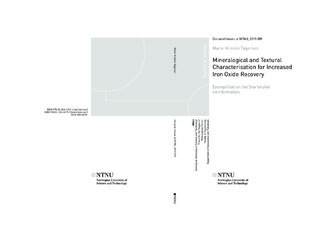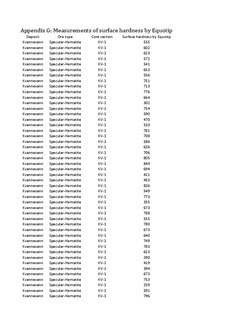| dc.description.abstract | Process mineralogy is increasingly becoming an important part of quality control in mining operations, and chemical assays are not sufficient for predicting metallurgical performance of complex ore deposits. Knowledge of mineralogical and textural ore properties that affect the mineral processing, may lead to better utilisation of the deposit, and the prediction of recovery becomes more solid.
The Storforshei iron formation (IF) is located in the Dunderlandsdalen valley c. 30 km northeast of Mo i Rana, Nordland county, Norway. The IF consists of highly metamorphosed and deformed hematite-magnetite ore deposits and belongs to the Uppermost Allochthon (UmA) in the Norwegian Caledonides. Rana Gruber (RG) mines deposits in the Storforshei IF, where the main products are hematite concentrates for pellets and sinter production, with magnetite concentrates for pigment production and water purification as a by-product. The main production today is from the Kvannevann deposit, but several other deposits have been in production previously. The deposits in the Storforshei IF show mineralogical and textural differences, and in order to investigate the effects of these differences on the metallurgical performance, a pilot circuit was constructed based on the hematite production line in the fullscale mineral processing plant. The pilot circuit consisted of autogenous milling, wet low intensity magnetic separation (LIMS), and wet high intensity magnetic separation (WHIMS). Three deposits were sampled for testing in the pilot circuit, Kvannevann, Stensundtjern, and Stortjønna. The aim of the pilot circuit was not to fully replicate the full-scale mineral processing plant, but rather to discover differences in the metallurgical performance of the deposits.
Six ore types were defined based on geological mapping and drill core logging from these three deposits, and their surface hardness were measured using Schmidt hammer and Equotip. The ore types are: Granular-Hematite, Specular-Hematite, Hematite-Magnetite, Magnetite-Ore, Mylonitic-Hematite, and Massive-Hematite. Granular-Hematite and Specular-Hematite have relatively coarse-grained hematite with straight grain boundaries, and low surface hardness.
The Kvannevann deposit, dominated by these ore types, had high grindability in the AG mill tests, and the mill circuit product had high hematite liberation. As the Kvannevann deposit samples were collected from drift development blasts in the underground mine, they had higher specific charge (Zang, 2016) compared to the Stensundtjern and Stortjønna which were collected from surface and open pit blasts. This and the low surface hardness in the ore types dominating in the Kvannevann deposit led to a larger amount of microcracks, and a higher grindability as a consequence. The Stensundtjern deposit is also dominated by these ore types, however, has substantial amounts of Hematite-Magnetite and Magnetite-Ore. These ore types have coarse-grained equant-irregular shaped magnetite with irregular grain boundaries, and higher surface hardness than the Granular-Hematite and Specular-Hematite. This together with a lower specific charge during blasting led to less microcracks in the Stensundtjern deposit sample, and likely caused the lower grindability observed for the Stensundtjern deposit sample compared to the Kvannevann deposit sample. The mill circuit product from the Stensundtjern deposit sample had slightly lower hematite liberation than the Kvannevann mill circuit product, which further indicates that there are differences in the ore type distribution between these two deposits.
The Kvannevann deposit sample performed well in the magnetic separation, yielding high Fetot* grades in the hematite concentrates, and with little loss of hematite to middlings and tailings, and with high hematite liberation in these outputs, further separation on these should recover this hematite. The content of non-economic or gangue minerals are low in the final hematite concentrates.
The Stensundtjern deposit sample preformed similar to the Kvannevann deposit sample in the magnetic separation, however, it had slightly higher content of composite particles. Thus, the loss of hematite to the middlings and tailings also were higher. The higher number of composite particles with hematite is also apparent from the lower hematite liberation in the tailings.
The Mylonitic-Hematite and Massive-Hematite ore types are very fine-grained, where the hematite occurs either disseminated in a matrix of gangue minerals with irregular-to-no visible grain boundaries, or as massive hematite without visible grain boundaries with irregularly folded layers or veins of gangue minerals. These ore types had the highest surface hardness values of all the ore types. The Stortjønna deposit sample had low grindability in the AG milling, and the specific energy consumption was much higher than in Kvannevann and Stensundtjern. This was attributed to the textures and surface hardness values in Mylonitic-Hematite and Massive-Hematite, as breakage of fine-grained rock without grain boundaries requires more energy (Xu et al., 2013), and because the amount of microcracks were, as a consequence of the higher surface hardness and lower specific charge in blasting, lower in the Stortjønna deposit sample compared to the Kvannevann and Stensundtjern deposit samples. The hematite liberation in the Stortjønna mill circuit product was lower than the corresponding outputs from Stensundtjern and Kvannevann, and the amount of composite particles with hematite was substantial. The particle textures in the Stortjønna mill circuit product corresponds to the textures observed in the Mylonitic-Hematite and Massive-Hematite. The particle distribution in the mill circuit product was broad and there was a notable amount of fines (< 38 μm). This caused challenges in the magnetic separation, as the separation efficiency decreases for fine particles in the WHIMS. Together with the presence of substantial amount of composite particles this led to high loss of hematite to the Stortjønna middlings and tailings. The hematite liberation in these outputs were low, thus, further separation will not improve the hematite recovery as much as it would for the ore types dominating in the Kvannevann- and Stensundtjern deposits.
Minerals containing Fe or Mn, like epidote, biotite/phlogopite, and hornblende, and dolomite were found in middlings and tailings from all the deposits, and as these are returned in the fullscale processing plant, an accumulation of these minerals in the WHIMS circuit might occur, which could lead to them eventually ending up in the final hematite concentrate.
Given that RG produces hematite and magnetite concentrates, the Fe recovery calculations should be based on Fe residing in these minerals, which is equal to the hematite or magnetite recovery, and not the Fetot* which provides no information of Fehem, Femag, and Fesil. The relationship between Fetot*, Fehem, Femag, and Fesil was investigated on samples from the fullscale mineral processing plant. The mill circuit products and tailings contain more Fesil than the hematite concentrates, thus, calculating the recovery based on Fehem or Femag rather than on the Fetot* content led to an increase in recovery for all the hematite concentrates analysed. The importance in these investigations lies in the determination of the amount of Fehem, Femag, and Fesil in the feed ore, as it provides a more solid prediction of the iron oxide recovery, and a prediction of how much Fe bearing non-economic minerals might end up in the hematite concentrates bringing undesirable elements like Mn, S, and alkalis with them.
By incorporating Equotip measurements in drill core logging, and geological mapping with focus on the ore types defined in this research, RG can easily improve the daily production quality control. However, analyses of modal mineralogy are also recommended, which together with mineral chemistry can be used to determine recoverable Fe located in iron oxides (Fehem and Femag) and the amount of Fe located in non-economic minerals (Fesil), hence, calculate real iron oxide recovery. | |

